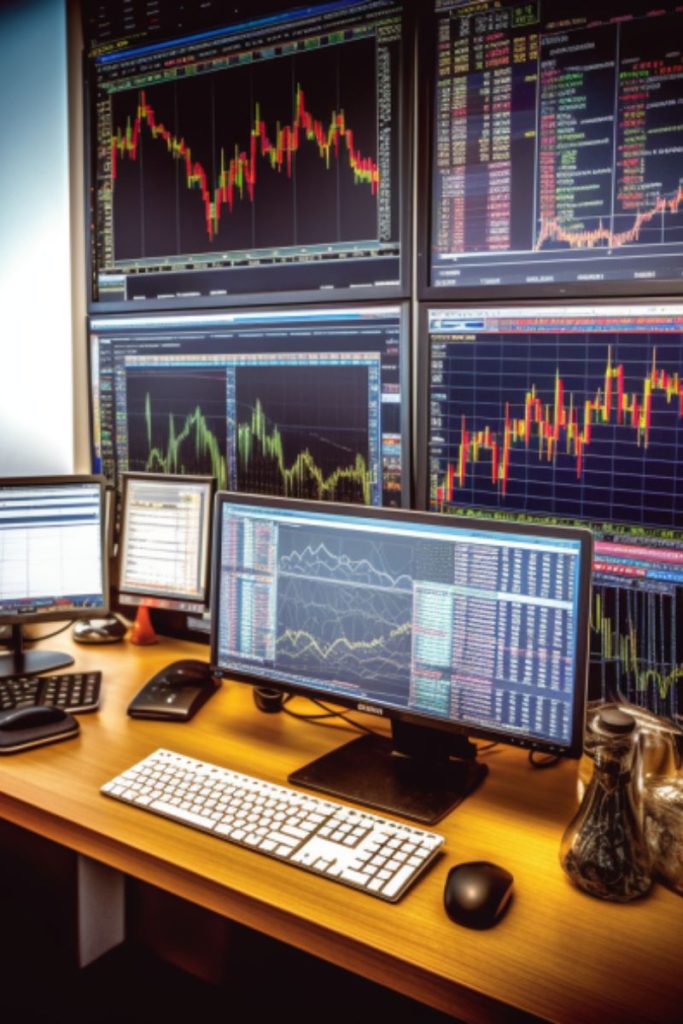Retail trading, or individual trading, has experienced an unprecedented rise in popularity in recent years, fueled by the accessibility and convenience of online trading platforms. Individual traders can now access financial markets from anywhere in the world and trade a wide range of assets, from stocks to cryptocurrencies. This article explores the world of individual traders, their characteristics, and how they differ from institutional traders. We will also delve into the pros and cons of retail trading, the importance of risk management, how technical analysis can be used to improve trading strategies, and common mistakes to avoid.
What is Retail Trading and How Does it Differ from Institutional Trading?
Retail trading refers to individual investors buying and selling financial securities through online trading platforms. These platforms provide retail traders access to financial markets that were previously only accessible to institutional investors, such as hedge funds and investment banks. Retail traders typically trade in smaller sizes compared to institutional traders and do not have access to the same level of market data and analysis. However, retail traders can still achieve profitability through careful analysis and risk management.
Institutional trading, on the other hand, involves large financial institutions, such as investment banks, pension funds, and mutual funds, buying and selling financial securities on behalf of their clients. Institutional traders have access to more resources, including advanced trading platforms, specialized teams of analysts, and high-frequency trading algorithms. Institutional traders also trade in much larger volumes, which can impact market prices.
The Pros and Cons of Retail Trading for Individual Traders
Retail trading offers several advantages to individual traders. One of the most significant benefits is accessibility. Retail traders can enter and exit trades quickly and easily, with low minimum deposit requirements and no need for extensive qualifications or experience. The rise of online trading platforms has made it possible for anyone with an internet connection to participate in the markets, regardless of their location.

Another advantage of retail trading is flexibility. Unlike institutional traders, who are often bound by strict guidelines and investment objectives, individual traders can adapt their strategies to changing market conditions and respond quickly to new opportunities. Retail traders can also trade in a variety of markets, including forex, stocks, and commodities, and choose from a range of financial products, such as options and futures.
However, retail trading also has its drawbacks. One of the main disadvantages is the lack of resources available to individual traders. Institutional traders have access to a wide range of research, analysis, and trading tools, whereas retail traders must rely on their own knowledge and experience. This can make it more challenging for retail traders to make informed trading decisions and stay ahead of the competition.
Another disadvantage of retail trading is the higher level of risk involved. Retail traders often have smaller account balances than institutional traders, which means that they are more vulnerable to market volatility and fluctuations. Additionally, retail traders may lack the experience or knowledge to effectively manage risk, which can lead to significant losses.
Understanding the Importance of Risk Management in Retail Trading
Given the higher level of risk involved in retail trading, it is essential for individual traders to understand the importance of risk management. Effective risk management can help traders to minimize their losses and protect their capital in volatile market conditions.
One of the most critical aspects of risk management is position sizing. Traders should never risk more than they can afford to lose on a single trade, and they should use position sizing techniques to ensure that their risk is always within acceptable limits. Stop-loss orders can also be used to limit losses on individual trades and help traders to manage their risk effectively.
In addition to position sizing and stop-loss orders, traders can also use diversification to manage risk. By spreading their investments across different markets and asset classes, traders can reduce their exposure to any single market or asset and minimize the impact of market volatility on their portfolio.
Technical Analysis and Retail Trading: How Individual Traders Can Use It to Their Advantage
Another important aspect of successful retail trading is the use of technical analysis. Technical analysis involves the study of past market data, primarily price and volume, to identify patterns and make informed trading decisions. Technical analysis is used by traders of all types, including retail traders, institutional traders, and algorithmic traders. However, it is particularly relevant to retail traders because it is accessible and easy to understand.
One of the most important concepts in technical analysis is the use of charts. Charts allow traders to visualize price movements over time and identify trends and patterns that may not be immediately apparent from raw data. There are several types of charts that traders can use, including line charts, bar charts, and candlestick charts. Each type of chart has its own strengths and weaknesses, and traders should choose the one that best fits their trading style.
In addition to charts, technical analysis also involves the use of technical indicators. Technical indicators are mathematical calculations based on price and/or volume data that help traders identify trends and potential trading opportunities. Some popular technical indicators include moving averages, relative strength index (RSI), and stochastic oscillator. Traders should be careful not to rely too heavily on any one indicator and should use a combination of indicators to confirm trading signals.
Another important concept in technical analysis is the use of support and resistance levels. Support levels are price levels at which demand is expected to be strong enough to prevent the price from falling further. Resistance levels, on the other hand, are price levels at which supply is expected to be strong enough to prevent the price from rising further. Traders can use support and resistance levels to identify potential entry and exit points for their trades.
Common Mistakes to Avoid in Retail Trading
While retail trading can be a profitable and exciting activity, it is also easy to make mistakes that can result in significant losses. Here are some common mistakes that retail traders should avoid:
- Lack of risk management: As we mentioned earlier, risk management is a critical component of successful trading. Traders should always use stop-loss orders to limit their losses and should never risk more than they can afford to lose.
- Overtrading: Overtrading is a common mistake that many retail traders make. Overtrading can lead to losses and can also result in traders missing out on potential profitable trades. Traders should have a clear trading plan and should stick to it, avoiding the temptation to make impulsive trades.
- Failing to adapt to changing market conditions: Markets are constantly changing, and traders need to be able to adapt to these changes in order to be successful. Traders should stay up to date on market news and events and should be prepared to adjust their strategies accordingly.
- Lack of discipline: Trading requires discipline and patience. Traders should avoid making emotional decisions and should stick to their trading plan. Failing to do so can lead to impulsive trades and significant losses.
- Lack of education and knowledge: Trading is a complex activity that requires a significant amount of education and knowledge. Traders should take the time to learn about the markets, trading strategies, and risk management before they start trading with real money. Look for a professional mentorship like ours to cut off years form your learning curve.

In conclusion, retail trading has become increasingly popular in recent years, thanks in large part to the rise of online trading platforms and the accessibility of trading to individuals. While retail trading offers many benefits, including accessibility and flexibility, it also comes with risks, and traders need to be prepared to manage those risks in order to be successful. By using risk management techniques, technical analysis, avoiding common mistakes and seeking the help of experienced traders and mentors, retail traders can increase their chances of success in the market.




